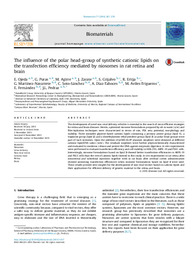Título :
The influence of the polar head-group of synthetic cationic lipids on the transfection efficiency mediated by niosomes in rat retina and brain |
Autor :
Ojeda, E.
Puras, G.
Agirre, M.
Zarate, J.
Grijalvo, S.
Eritja, R.
Martinez Navarrete, Gema 
Soto-S anchez, C.
Díaz-Tahoces, Ariadna 
Aviles-Trigueros, M.
Fernández, E.
Pedraz, J.L. |
Editor :
Elsevier |
Departamento:
Departamentos de la UMH::Fisiología |
Fecha de publicación:
2015-11-14 |
URI :
https://hdl.handle.net/11000/35411 |
Resumen :
The development of novel non-viral delivery vehicles is essential in the search of more efficient strategies
for retina and brain diseases. Herein, optimized niosome formulations prepared by oil-in water (o/w) and
film-hydration techniques were characterized in terms of size, PDI, zeta potential, morphology and
stability. Three ionizable glycerol-based cationic lipids containing a primary amine group (lipid 1), a
triglycine group (lipid 2) and a dimethylamino ethyl pendent group (lipid 3) as polar head-groups were
part of such niosomes. Upon the addition of pCMS-EGFP plasmid, nioplexes were obtained at different
cationic lipid/DNA ratios (w/w). The resultant nioplexes were further physicochemically characterized
and evaluated to condense, release and protect the DNA against enzymatic digestion. In vitro experiments
were performed to evaluate transfection efficiency and cell viability in HEK-293, ARPE-19 and PECC cells.
Interestingly, niosome formulations based on lipid 3 showed better transfection efficiencies in ARPE-19
and PECC cells than the rest of cationic lipids showed in this study. In vivo experiments in rat retina after
intravitreal and subretinal injections together with in rat brain after cerebral cortex administration
showed promising transfection efficiencies when niosome formulations based on lipid 3 were used.
These results provide new insights for the development of non-viral vectors based on cationic lipids and
their applications for efficient delivery of genetic material to the retina and brain.
|
Palabras clave/Materias:
niosomes
gene delivery
non-viral vector
cationic lipid
retina
brain |
Tipo de documento :
info:eu-repo/semantics/article |
Derechos de acceso:
info:eu-repo/semantics/openAccess
Attribution-NonCommercial-NoDerivatives 4.0 Internacional |
DOI :
10.1016/j.biomaterials.2015.11.017 |
Publicado en:
Biomaterials . 2016 Jan:77:267-79 |
Aparece en las colecciones:
Artículos Fisiología
|
 La licencia se describe como: Atribución-NonComercial-NoDerivada 4.0 Internacional.
La licencia se describe como: Atribución-NonComercial-NoDerivada 4.0 Internacional.
.png)
